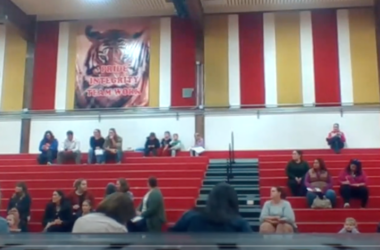A few years ago, my colleague Judy Muller and I were brainstorming about how students could get out of their “bubbles” and talk with people whose lives were very different from their own.
Judy had lived for many years in rural Colorado and was about to set up house full time there. I’ve spent a fair amount of time in dairy country of upstate New York, where my mother-in-law copy-edited the local newspaper in addition to her job as a sixth-grade teacher.
We both believed in the importance of local journalism and the value in listening to people who don’t live in major cities. Eventually, we decided there was really only one good way to do it –we’d bring the students to a rural area to report.
Fast forward through a pandemic and other major life events and this spring we were ready for our second round of a session we call Rural Reporting. Judy found Les Zaitz through a mutual acquaintance. As soon as we met him, we knew he’d be a fantastic guide and mentor for our students.
In January, Les came to USC’s Annenberg School for Communication and Journalism in Los Angeles to meet and visit with our cohort. He pitched the students a few possible topics, including environmental ones. They were most interested in tackling the issue of child poverty –probably the most difficult and complicated of the choices.
Over the weeks, they fielded at least a dozen iterations of the question about who they were and what in the world they were doing in Malheur County.
During the semester, we checked in periodically with Les via Zoom, and the students worked their way through the reports and statistics he suggested. Les started by asking them the most basic of questions: What does childhood poverty mean?
Answers generated by the students gave them a blueprint to look at the complex constellation of factors that led to Malheur County having the highest rate of childhood poverty in the state. As is usually true in journalism, though, the best reporting happened when they were on the scene in person.
When we arrived in Caldwell, Idaho, on an unseasonably warm Sunday in May, we were all nervous and probably a little bit scared.
Les started off by giving them a long – and I mean very long – list of people to contact. His name and reputation opened doors for them, but they had to go in and do the work themselves. They quickly learned they would need to navigate a sea of new and unfamiliar agencies across several locations. DPS, OSP, OHA, which places had a police department and which relied on deputies. They rapidly got up to speed on critical differences in drug policy, minimum wage and housing prices between Idaho and Oregon.
Most importantly, though, they listened, often to stories which were difficult to hear.
One student told us she couldn’t stop thinking about the field worker who described seeing her children cold and hungry during lean times. Two of our students came back to the house we shared covered in mosquito bites from the time they spent with a deputy in a homeless encampment by the river.
Several young reporters met the volunteer coordinator of a rural food bank, who cried when she described what the pantry meant to people, and how much it would be missed when forced to close at the end of the month.
Others spent a day with the homeless liaison for a school district whose job involves providing food, clothing and emotional support to young people without a stable place to live. They were there when she told one of her teens that she loved him, and he responded that he loved her too. That was just one of the many instances they witnessed of educators’ quietly heroic responses to poverty.
At least two of the people the students interviewed had spent time in prison or jail and described the clear connection to their financial struggles. While challenging, these experiences gave the students an understanding of the scope and seriousness of the issue, and what it meant to so many people’s lives. They conveyed that in what they wrote, filmed and photographed.
Of course, they also had fun. They marveled at the beauty of the Owyhee Canyon, the Snake River and the miles of green fields around Adrian. They chowed down at the Nyssa Nite Rodeo and became regulars at Mal’s Diner and the Perk in Vale. They made a meme out of the Malheur Enterprise resident office cat.
We all enjoyed getting to know a bit of Boise, and they took to playing the video game version of the Oregon Trail at night, with a new appreciation for the real-life difficulties.
They also put in tremendous effort. We logged hundreds of miles in our Suburban and they worked late into the night most evenings. Over the weeks, they fielded at least a dozen iterations of the question about who they were and what in the world they were doing in Malheur County – delivered with various gradations of politeness depending on the speaker. The students answered with grace and generosity.
As an educator, I’m grateful to Les for providing our students the chance to work on a significant story in a working newsroom. His calm but pointed questions helped them understand when they needed to ask more questions – which was almost always! They learned the importance of persistence and deep listening.
One student told us she realized she had to really push officials for answers – that after one interview, she could see she hadn’t actually gotten a satisfactory response to her query. Most of the students felt overwhelmed at some point with the sheer volume of material they had amassed from the more than 70 interviews conducted over the course of our two weeks in Oregon, along with the previous research.
After we left Oregon, they all volunteered to spend extra time writing and revising because they were so invested in the outcome. With help from Les, they whittled their reporting into a cohesive structure, sharpened the details and filled in the gaps to create a unified whole.
I’m gratified with how the students rose to the challenge. Their series brings me as much pride as any of the student work I’ve been involved in during my 10 years at USC. The response from the community, and the possibility for real change, makes it all the more meaningful.
Rebecca Haggerty is an associate professor and associate director of undergraduate journalism studies at USC’s Annenberg School of Journalism and Community. She helped lead work on the series “Children of Poverty.”
CHILDREN OF POVERTY: The series and videos
EDITOR’S NOTE: Local journalism like this is disappearing across Oregon and the country. Show your support for this sort of work with a one-time donation to our Journalism Fund. Every dollar matters. No matter if you chip in $10 or $1,000, your generosity will ensure continued in-depth reports that matter: I WANT TO DONATE.



